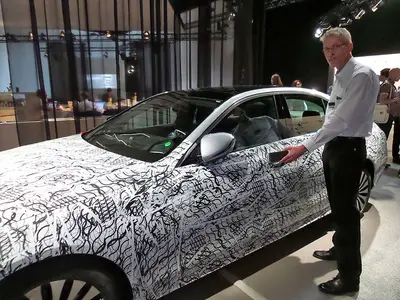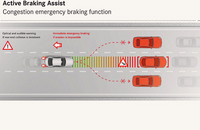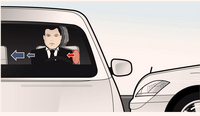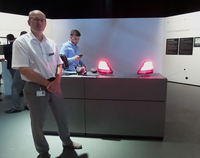2016 Mercedes-Benz E-Class Packed With New Safety Systems +VIDEO
 2016 Mercedes-Benz E Class - Andreas Pohlmann demos Digital Car Key feature |
By Henny Hemmes
Senior European Editor
 2016 Mercedes-Benz E Class - Active Braking Assist |
DINGOLFING, Germany: Next year, the new generation Mercedes-Benz E-Class will arrive in showrooms worldwide with the latest innovations. Previously, I wrote about the Car-2-X communication but there is more, and I'll now highlight the other technologies that Mercedes presented during the E-Class Tech Day.
In preparing its cars for the autonomous driving era, Mercedes introduced the Pre-Safe system quite a while ago and it's been continuously enhanced and extended. One such measure is Active Braking Assist, an enhancement of Automatic Braking. This function can warn the driver of imminent crash situations and assist in the event of an emergency stop and, if necessary, apply the brakes automatically. The system detects stopped, stopping, or slower moving vehicles and reacts to crossing traffic at junctions as well as the tail ends of traffic jams and pedestrians walking in the path of the car.
Another innovation is Evasive Steering Assist, which complements the pedestrian detection function of Active Brake Assist and assists the driver when he or she deliberately or instinctively makes an evasive steering maneuver in a dangerous situation. It helps the driver by adding calculated steering torque to evade pedestrians and helps straightening the vehicle to pass safely. However, the car cannot avoid them all by itself...at least not yet.
Automated Parking is not new, but fairly new is that the driver can stand outside the vehicle and watch the car park itself. We saw it demonstrated during the backgrounder of the upcoming BMW 7 Series and now also the E-Class will get this automated function. Where BMW uses a special key with a small touch screen, Mercedes lets you use your cell phone, which can be also used as a Digital Car Key. This a function of the smart phone based on NFC (Near Field Communication) that enables people to not only use their phone to open a vehicle but offers many more possibilities, such as remote parking. Automatic parking is possible via the blue tooth function of the smart phone, which must be within 10 feet of the car.
Opening of the door itself is done by holding the phone near the door handle. Andreas Pohlmann, responsible for locking systems, said during his demonstration with the E-Class in disguise: "Compare it with the new way of paying, where you hold the bank card close to the pin devise in stores. Mercedes uses an NFC interface close to the door handle on the driver's side. If the smart phone can communicate via NFC and is equipped with a Secure SIM, it can be used as an authorization system for drivers. This enables fleet managers with a smart phone "manage" up to 250 cars. Mr. Pohlmann said that the next step will be using the technology for rental cars.
 Mercedes-Benz E Class Pre-Safe Impulse side protection |
Three years ago, Mercedes introduced ‘belt bags’ in the more expensive variants. The safety belts were developed for the outer rear seats to provide passengers extra protection during head on collisions. In such cases the belt bag is inflated up to three times the normal width. The sensors that register such collisions are part of the existing Pre-Safe occupant protection. Pre-Safe features several measures to move occupants into the best possible position just before the impact. Belt bags will be offered in the 2016 E-Class, that will also get Impulse Side Protection. This system uses an airbag in the side bolster of the seat to move the occupant away from the door and towards the center of the car just before the impact.
Ralf Bogenrieder, the responsible engineer, explains that the airbag is filled with gas from a canister mounted in the back rest: “This increases the crumple zone by some 1.2 to 2 inches. In tests, we have found that the relative speed between the occupant is reduced and that the load on the rib cage is reduced up to 50 per cent.” Mr. Bogenrieder then invited me to take a seat on the test bed and experience myself how it feels to be pushed aside. Well, it feels like a little ‘push’ that happens so quickly that you hardly notice it.
Another innovation is Pre-Safe Sound, an innovation Mercedes is using as a natural reflex to prepare the ears of occupants for the loud noise of an accident. Nature already has provided our ears with a muscle, the stapedius, that reacts to loud noises by reflexively contracting, thus changing the link between the ear drum and the inner ear, which provides better protection against high sound pressures. Mercedes uses the natural reflex as biomechanical ear protection and have Pre-Safe Sound emit a short interference signal through the car’s sound system is the risk of a collision is detected. The signal triggers the stapedius reflex, preparing the ears for the noise in order to decrease the risk of hearing discomfort or damage.
Multibeam LED headlamps were introduced in 2014 on the CLS and the upcoming E-Class will also get them. Each headlamp has 84 instead of 24 LED lamps, which are individually controllable and can dim and close the high beam. Some functions are based on navigation and some on a combination with the use of sensors and cameras. The new lighting system makes night time traffic much safer for all road users. According to German statistics, there are five times as many accidents with serious injury during night time than during the day. Night time driving accounts for 20 per cent of all accidents, but nearly half of them are fatal.
 Mercedes-Benz E Class - Jens Martin demos Varying Light Intensity feature |
Did you ever have to cover your eyes when waiting behind a car at night? I did, especially since more cars have LED brake lights, which shine so bright that you are blinded. The Mercedes brake lights will have varying light intensity. During day time it will be a 100 per cent. At night it will be 80 per cent and during a stop it will be 60 per cent.
Jens Mertens, responsible for Light Systems Technology and Concept Validation showed the units on display. “Not only the rear lights, but also the Multibeam LED head lights are really increasing safety," he said. The Adaptive Highbeam Assist Plus has been further optimized thanks to a larger number of pixels, the dark areas in the light distribution are more precise than before and the main beam can be used for a longer period than before.”
The E-Class will be the first Mercedes model with the new systems, but soon the renewed S-Class will follow and will also have more innovations that will improve safety and that will get us closer to autonomous driving.


